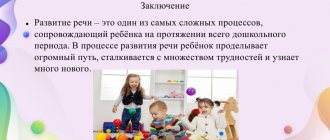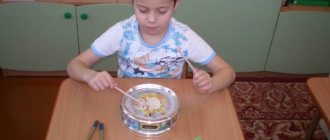Perceptual impairments in persons with speech impairments
4.1. Perception as a mental characteristic
Perception
is a system of processes for receiving and converting information that provides the body with a reflection of objective reality and orientation in the surrounding world.
A.R. Luria gives the following characterization of perception: “Perception is a complex analytical-synthetic work that identifies some essential and inhibits other unimportant features and combines perceived details into one meaningful whole.” There are types of perception: according to the leading analyzer (visual, auditory, tactile, olfactory, gustatory, kinesthetic); according to the form of existence of matter (perception of space, time, movements); by the form of mental activity (intentional, unintentional); by structure (simultaneous, successive). Perception has its own properties:
1. Meaningfulness and generality: when perceiving objects and phenomena, a person is aware and understands what is perceived.
2. Objectivity: a person recognizes mental images of objects not as images, but as real objects.
3. Integrity: perception is always a holistic image of an object.
4. Structurality: a person recognizes various objects thanks to the stable structure of their features. In perception, the relationships between the parts and sides of an object are identified.
5. Selectivity: from a countless number of objects and phenomena, a person at a given moment singles out only those to which his activities, needs and interests are directed.
6. Constancy: the same objects are perceived by a person in changing conditions. However, the objective qualities of objects are perceived unchanged.
Sensory development
- this is the development of the processes of perception and ideas about objects and phenomena of the surrounding world. A child is born with formed sense organs. But their normal functioning is only a prerequisite for the perception of the surrounding world.
In order for sensory development to take place fully, targeted sensory education is necessary. The child should be taught to look at, feel, and listen to objects, i.e. form his perceptual actions. Examining an object, seeing it, touching it is not enough. It is necessary to determine the relationship of the identified properties and qualities of a given object to the properties and qualities of other objects.
To do this, the child needs standards with which to compare what he currently perceives. These are sensory standards that have developed historically and allow us to compare and contrast the results of perception. These include geometric shapes, scales of magnitude, weights, pitches, colors, and the phoneme system of the native language.
All these standards must be mastered by the child in a timely manner. In the process of perception, he gradually accumulates visual, auditory, motor, and tactile images. The properties and relationships of objects that the child perceives must be denoted by words, which helps to consolidate the images of objects in the mind, making them more accurate and stable. If images of perception are fixed in a word, they can be recalled in the child’s mind even after some time. To do this, just say the corresponding word - the name.
4.2. Peculiarities of perception in speech disorders
Agnosia
(from the Greek a - negative particle and gnosis - knowledge) - loss of the ability to perceive objects and phenomena of reality with lesions of the cerebral cortex and subcortical structures.
4.2.1. Visual perception
The occipital region of the cerebral hemispheres provides the processes of visual perception. In this case, visual perception itself (visual gnosis) is provided by the secondary sections of the visual analyzer in their relationship with the parietal structures. When the occipito-parietal parts of the brain are damaged (both the left and right hemispheres), visual agnosia occurs. In neuropsychology, there are object, simultaneous, facial, symbolic and color agnosias.
Object agnosia
– the absence of a recognition process or a violation of the integrity of the perception of an object with the possible identification of its individual features or parts. It has varying degrees of severity - from maximum (agnosia of real objects) to minimum (difficulty recognizing contour images in noisy conditions or when superimposed on each other).
Simultaneous agnosia
– the impossibility of simultaneous perception of several visual objects or a situation in a complex. Only one operational unit of visual information is perceived, which is currently the object of attention. In some cases, only difficulties are observed in the simultaneous perception of a complex of elements with the loss of any details or fragments. These difficulties can manifest themselves when reading or drawing. Simultaneous agnosia may be accompanied by disturbances in eye movements (gaze ataxia).
Facial agnosia
– impaired memory of faces (from failure to recognize familiar faces or photographs to failure to recognize oneself in the mirror). Symbolic agnosia is a disorder in the perception of symbols characteristic of familiar language systems; the ability to identify letters and numbers while maintaining their spelling is impaired.
Color agnosia
– difficulty in differentiating mixed colors.
E.P. Kok (1966) highlights:
subject,
optical-spatial (apractognosia),
letter and number agnosia,
agnosia for colors and faces.
Features of visual perception in children with speech impairments
G.L. Rosegart-Pupko (1966) directly speaks of the close interaction between speech and visual object perception. Perception and speech are interdependent in their formation: the constancy and generality of perception, on the one hand, and the mobility of visual images, on the other, are formed and developed under the influence of words. Thus, as a result of a study of visual perception in preschool children with speech pathology, data were obtained about the insufficient formation of a holistic image of an object, while simple visual recognition of real objects and their images does not differ from the norm (L.I. Belyakova, Yu.F. Garkusha, O N. Usanova, 1991).
Difficulties appear when tasks become more complex (recognition of objects in conditions of overlap, noise). Children with ODD perceive the image of an object in complicated conditions with difficulties: the time of decision-making increases, they are not sure of the correctness of answers, identification errors are noted, the number of which increases with a decrease in the number of informative features of objects.
In implementing the task of perceptual action (trying on a standard), children with SLD more often use elementary forms of orientation, i.e. by trying on a standard, in contrast to children with normal speech, who predominantly use visual correlation. Children with ODD often, when trying on figures, are guided not by their shape, but by color.
Preschoolers with OHP also have a low level of development of letter gnosis: they have difficulty differentiating between normal and mirror spelling of letters, do not recognize letters superimposed on each other, have difficulty in naming and comparing letters that are graphically similar, in naming letters in printed font given in disorder . In this regard, many children are not ready to master writing. When studying the features of orientation in space, it turned out that they find it difficult to differentiate the concepts of “right” and “left”, and cannot orient themselves in their own body, especially when the tasks become more complex.
In a study of children of primary school age with delayed speech development (SDD), dysarthria, and alalia, the following gnostic functions were studied: optical-spatial gnosis, facial gnosis, digital and oral stereognosis (E.M. Mastyukova, 1976). Thus, violations of optical-spatial gnosis are considered characteristic of children with organic brain damage. Studying it using L. Bender’s methodology and during observations of children’s activities in the process of drawing, designing and learning to read and write, it was revealed that this function in children of primary school age with speech pathology, compared to children with normal speech, is at a much higher level. low level.
The dynamics of development of spatial perception are most favorable in children with mental retardation, and least favorable in children with alalia. Spatial disturbances persist especially persistently in human drawings: the image is characterized by poverty, primitiveness and a small number of details (especially in alaliks).
Subsequently, at school, the role of spatial impairments in the persistence of written language disorders (dyslexia and dysgraphia) and counting disorders is great. Studies of the ability to establish spatial relationships between the phenomena of reality in object-practical activity and understand them in impressive speech indicate the preservation of these abilities, but in expressive speech children with SLI often do not find linguistic means to express these relations or use incorrect linguistic means. This is due to a disruption in their processes of recoding a preserved semantic program into a linguistic form.
Studies of facial gnosis (using the Tardieu technique) show a relationship between its impairments (especially in the area of oral muscles) and the severity of sound pronunciation disorders. Severe impairments of facial gnosis are characteristic of children with dysarthria and alalia.
Impairments of oral and digital stereognosis were studied using general methods described in the literature and using the method of R.L. Ringel, when the child was asked to determine the shape of objects placed in his mouth with his eyes closed, then show such a figure in a set. The most pronounced disorders were observed in children with pathology of the phonetic aspect of speech (alalia, dysarthria, dyslalia). Also, significant violations of oral stereognosis are observed in children with a gross violation of facial gnosis (low indicators of identifying points in the picture and the subject’s face). No impairments of finger stereognosis were identified in children with speech disorders (E.M. Mastyukova, 1991).
L.S. Tsvetkova (1995) studied the accuracy, volume and strength of perception of objects and their memorization (drawing by word - name, completing the drawing of a given part to the whole, abstract elements, etc.) in primary schoolchildren with DLD. Thus, in children with normal speech there were no violations of visual perception and ideas, but in children with SLI there were no violations of visual memorization and recognition, poverty of images, sketchiness in drawings, and disturbances in connection with the word - name.
According to A.P. Voronova, preschoolers with ODD, compared to normally developing children, do not have any visible deviations in visual recognition of objects. Difficulty was observed in difficult cases in situations of overlap, noise, and also in the study of letter gnosis. When compiling a story based on a chain of plot pictures (successive gnosis), children with ODD spent more time arranging the pictures in the required order, could not identify temporary, cause-and-effect relationships, did not understand the meaning of the plot, and were unable to compose a full story. When examining opto-spatial gnosis in children with OHP, difficulty was revealed in differentiating the right and left sides and confusing the understanding of prepositions denoting spatial relationships.
Also, underdevelopment of optical-spatial gnosis is observed in children with all forms of motor impairment (congenital and early acquired orthopedic diseases, myopathies and muscular dystrophies, cerebral palsy) (I.I. Mamaichuk, Mendoza, 1988; I.I. Mamaichuk, 1976; E.S. Kalizhnyuk, E.V. Sapunova, 1975). These disorders are temporary, and with the start of independent walking they are easily compensated. According to I.I. Mamaichuk (1976), in children with cerebral palsy (dysarthria) in 70 to 85% of cases there is a lag in visual perception of color, shape, and visual activity. Children with cerebral palsy, when perceiving colors and geometric shapes, have difficulty verbally denoting them, are poorly able to construct and assemble cut pictures and cubes, and copy shapes, which indicates impairments in visual perception and spatial relationships.
In the studies of L.M. Wekker and his students (Wekker et al., 1971), devoted to the problem of the phase dynamics of the formation of a perceptual image, when removing internal interference in schoolchildren with cerebral palsy, the phases of the formation of perceptual images were identified. A comparison of images of flat figures after tactile and visual perception showed that in children with cerebral palsy the drawings correspond to topological adequacy, and in healthy children - to the metric characteristics of objects.
Thus, it has been experimentally revealed that visual impairments in children with severe speech pathology manifest themselves mainly in the poverty and undifferentiation of visual images, inertia and fragility of visual traces, as well as in the absence of a strong and adequate connection between the word and the visual representation of the object.
4.2.2. Auditory perception
The auditory cortex occupies the outer (convexital) parts of the temporal region of the brain and is divided into primary (projection) and secondary zones. The auditory pathway, carrying signals of sound stimuli, begins in the organ of Corti, located in the cochlea of the inner ear. Individual sections of this organ are excited in response to vibrations of different heights, and the nerve fibers transmitting these vibrations retain their somatotopic organization. They follow the auditory pathway, are interrupted in the internal geniculate body and end in the primary (projective) sections of the auditory cortex, located in Heschl’s transverse gyrus.
It is possible to distinguish two objective systems that have developed in the process of the social history of mankind and are related to auditory perception: rhythmic-melodic (musical), phonemic (sound codes of language) code systems.
The system of rhythmic-melodic (or musical) codes determines musical ear. The phonemic system determines the process of sound perception and ensures the coding of its individual elements into complex forms of sound perception; it is a system of sound language.
Auditory perception is an active process that includes motor components (singing with a voice for musical hearing and pronunciation for speech hearing).
The clinical and neuropsychological literature describes disorders of auditory functions that occur when the nuclear zone of the auditory system of the right and left hemispheres is damaged (auditory agnosia).
Auditory agnosia
– gnostic disorder, reflecting a violation of auditory perception, with preserved elementary sensitivity.
Depending on the level of damage to the auditory system, there are:
1) actual auditory agnosia;
2) arrhythmia;
3) amusia;
4) violation of the intonation side of speech (prosody);
5) speech acoustic agnosia.
Actually auditory agnosia.
People do not understand the meaning of the simplest sounds (the creaking of doors, the sound of footsteps), i.e. everyday sounds that a person can normally distinguish without special training. Such sounds cease to be carriers of meaning, although their physical hearing is preserved. Arrhythmia. The child cannot correctly evaluate the rhythmic structures that are presented to him by ear and reproduce them. There is a violation of the timbre of speech, an inability to memorize poetry, and shortening of words.
Amusia.
The ability to recognize and reproduce a familiar melody or one that a person has just heard, as well as to distinguish one melody from another, is impaired. A child with amusia not only cannot recognize a melody, but also evaluates it as a painful and incomprehensible experience (music causes headache attacks and becomes actively unpleasant). Violation of the intonation side of speech. The intonation aspect of speech is disrupted. Patients do not distinguish speech intonations, their speech is not expressive, devoid of modulations and intonation diversity.
Speech acoustic agnosia.
A person loses the ability to clearly distinguish speech sounds. He retains fairly acute hearing. Significant impairments are observed only when distinguishing speech sounds. With massive lesions of the left temporal lobe, all speech sounds are perceived as inarticulate noise. In cases of limited lesions, the defect is less pronounced - a person cannot distinguish only close “oppositional” phonemes that differ only in one feature (phonemic perception is impaired), although he can detect timbre and intonation. Speech acoustic agnosia is the source of speech disorders - sensory aphasia and alalia.
Features of auditory perception in children with speech impairments
While studying phonemic perception, G.F. Sergeeva (1973) notes that dysfunction of the speech motor analyzer in dysarthria and rhinolalia significantly affects the auditory perception of phonemes. However, there is not always a positive correlation between impaired pronunciation and the perception of sounds. Thus, in a number of cases, there is a hearing differentiation of those phonemes that are not contrasted in pronunciation, while in other cases, those phonemes that are differentiated in pronunciation are not distinguished. Moreover, the greater the number of sounds differentiated in pronunciation, the more successful the differentiation of phonemes by ear is. And the fewer “supports” in pronunciation, the worse the conditions for the formation of phonemic images. The development of phonemic perception is directly dependent on the development of all aspects of speech (vocabulary, grammar, phonetics).
The use of diffuse sounds of unstable articulation, distortion of sounds correctly pronounced outside speech in an isolated position, numerous substitutions and confusions with a relatively formed structure and function of the articulatory apparatus indicate immaturity of phonemic perception.
Thus, with acoustic-phonemic dyslalia, the child does not recognize one or another acoustic feature of a complex sound, by which one phoneme is opposed to another. Due to the lack of recognition of one or another feature, the sound is recognized incorrectly. This leads to incorrect pronunciation of sounds due to the primary immaturity of the function of auditory discrimination of phonemes that are similar in acoustic similarity. With articulatory-phonemic dyslalia, substitutions and mixtures are carried out on the basis of the articulatory proximity of sounds that differ in one of the characteristics. With this form, phonemic perception is most often fully formed, or suffers secondarily. If the child does not distinguish phonemes, then the basis is confusion based on articulatory similarity.
When diagnosing auditory perception disorders, several levels of development of speech understanding in children with ODD can be distinguished.
1. Zero: does not perceive the speech of others, sometimes reacts to his name, less often to intonations of prohibition or encouragement.
2. Situational: understands requests related to the everyday objective world, knows the names of loved ones and the names of his toys, can show body parts of himself, his parents, dolls, but does not distinguish, based on a verbal request, images of objects, toys that are well known to him in everyday life.
3. Nominative: well versed in the names of objects depicted in the pictures, has difficulty understanding the names of the actions depicted in the plot pictures (walking, sitting). Does not understand questions of indirect cases (with what? to whom? with whom?).
4. Predicative: knows many names of actions, easily navigates questions of indirect cases posed to objects of actions depicted in plot pictures, distinguishes the meanings of several primitive prepositions (put on the box, in the box, etc.). Does not distinguish between grammatical forms of words.
5. Dissected: distinguishes between changes in meanings introduced by individual parts of the word (morphs) - inflections, prefixes, suffixes (“table – tables”, “flew away – flew in”).
Peculiarities of auditory perception in adults with speech impairments With acoustic-mnestic aphasia, while maintaining the phonemic structure of speech, and without showing massive phenomena of alienation of meaning, patients are not able to maintain a series of auditory-speech traces with the required strength, they easily lose them under the influence of pauses or side effects and themes thereby depriving them of the opportunity to provide a stable series of sequential auditory-speech chains.
With acoustic-gnostic (sensory) aphasia, patients’ hearing for music is not impaired, but they do not distinguish phonemes that are close in acoustic similarity (d-t, z-s, zh-sh, ts-ch, etc.), therefore they experience difficulties in understanding speech addressed to them. Non-speech sounds are distinguished well (the ticking of a clock, the sounds of dishes, etc.). It is also difficult to perceive rhythms.
4.2.3. Tactile (tactile) perception
Damage to the secondary fields of the parietal cortex of the brain is accompanied by tactile agnosia - impaired recognition of the shape of objects with relative preservation of superficial and deep sensitivity. The history of the study of tactile agnosia begins in 1884, when the failure to recognize objects by touch was first described. In the clinical literature, there are two main syndromes: inferior parietal and superior parietal.
Inferior parietal syndrome is associated with a disorder of complex forms of tactile gnosis (astereognosis or tactile object agnosia). This is a violation of the ability to perceive objects by touch, the inability to integrate tactile sensations coming from an object. A person correctly perceives an object visually, but does not recognize it with his eyes closed. By feeling small objects, a person correctly evaluates the individual characteristics of the object. However, he cannot identify it as a whole.
There are difficulties in perceiving the material from which the object is made (roughness, smoothness, softness, hardness). The ability to recognize letters written on the skin is often impaired (tactile alexia).
Some authors identify “tactile amnestic aphasia” - the inability to name an object palpated with eyes closed while retaining its correct description and purpose. Other authors believe that this is a manifestation of amnestic aphasia.
Upper parietal syndrome is a violation of the “body diagram” or somatoagnosia (disorder of recognition of body parts and their location in relation to each other). Thus, the ability to draw a figure previously identified by touch suffers to a greater extent with damage to the posterior parts of the parietal cortex, and tactile gnostic disorders manifest themselves to a greater extent with damage to the anterior parts of the parietal cortex.
Disorders of language acquisition
The psychological and pedagogical classification determines the content and conditions for the implementation of the educational program, which can be mastered by a child with normal physical hearing and intact intelligence, starting from the age of 4. Types of speech disorders, according to this approach, are described in accordance with how the child masters and uses the language system - its phonetic, lexical and grammatical means - in oral and written speech.
Disturbances in the development of the language system manifest themselves in different ways.
Phonetic-phonemic underdevelopment (FFN)
is expressed in a violation of pronunciation (distortion, confusion, substitution, absence of sound) and perception, discrimination of speech sounds.
Phonetic disorder (PHI)
is expressed only in the distorted pronunciation of sounds while their perception and discrimination are intact.
General speech underdevelopment (GSD)
is defined as the immaturity of all components of the language system in children with normal hearing and initially intact intelligence. This disorder manifests itself both in the child’s own speech and in the process of understanding speech addressed to him. It affects pronunciation and recognition of sounds, vocabulary, grammatical formatting of statements, and text construction.





